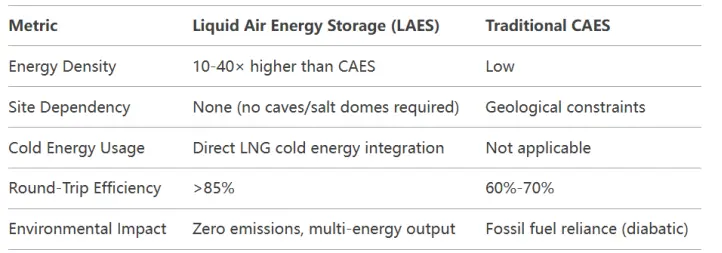Applications of Liquid Air Energy Storage

Applications of Liquid Air Energy Storage
Energy Storage Phase:
– Utilize LNG cold energy (-162°C) to precool compressor inlet air, reducing compression power consumption.
– Enhance air liquefaction efficiency by combining cold energy from LAES’s cold storage unit (stored during discharge phase) with LNG cold energy.
Energy Discharge Phase:
– Release cold energy during liquid air regasification, which is recycled into the cold storage medium.
– Compressed heat stored during the storage phase reheats high-pressure air to drive turbines for power generation.
Advantages of LAES Coupled with LNG Cold Energy
1. Significant Energy Efficiency Improvements
– Round-Trip Efficiency >85%: LNG cold energy precooling and cold storage cycles reduce compression energy loss, outperforming traditional Compressed Air Energy Storage (CAES) (60%-70%).
– Cold Energy Utilization Doubled: Direct integration of LNG cold energy boosts air liquefaction rates by >20%, minimizing reliance on conventional refrigeration.
2. System Flexibility and Economic Benefits
– Site Flexibility: No geological dependency (e.g., salt caverns); deployable near LNG terminals or urban load centers (Guangxi project requires only 70 mu).
– Lower Capital Costs: 30%-40% reduction in unit investment costs compared to traditional storage technologies, with 100% domestic equipment localization.
– Wide Load Range: Supports dynamic load adjustment (5%-110%) and rapid start-stop response (<10 minutes).
3. Environmental and Strategic Value
– Zero Emissions: Air as the working medium eliminates chemical pollution; LNG cold energy recycling mitigates ecological impacts from cold discharge.
– Carbon Neutrality Support:
– Annual CO₂ reduction: 86,000 tons (e.g., Guangxi project).
– Enhances renewable energy integration and grid decarbonization.
4. Technical Maturity and Scalability
– Proprietary IP Portfolio: 23 patents filed (17 invention patents), including breakthroughs in cold storage temperature gradient control and ultra-low-energy air purification.
– Modular Scalability: Adaptable to 50MW-100MW projects, compatible with LNG terminals of varying scales.
Comparison with Conventional Technologies


